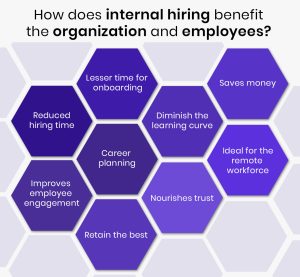
Internal hiring lays emphasis on hiring current employees for open positions in the organization. The practice brings many advantages for the organization and employees alike.
Employees who are with an organization for the long term have good exposure to its culture and policies. Hiring them for new openings is a great strategy because of their potential to motivate the workforce and improve organizational productivity. Whether to hire from within or recruit externally is a decision that must be taken after carefully assessing the existing skill sets and the talent available in the job market.
Internal hiring usually results in promoting the performing employees to higher positions within the organization. Employees may also change their roles and move to a different department without any changes in the level of authority. Many managers believe that hiring from within is the best strategy to retain top talent and improve employee loyalty.
External hiring is expensive and requires the HR team to spend more time and effort in hunting for the right candidates. It involves many cumbersome tasks such as placing job ads, searching social media, outsourcing to recruitment agencies, and gathering referrals. Instead of resorting to these costly recruitment strategies, many organizations are realizing the advantages of internal recruitment and prefer to fill their open positions from within.
How does internal hiring benefit the organization and employees?
External candidates would bring new ideas and perspectives to the organization. But, you might want to consider internal hiring in many situations because of the following benefits.

- Reduced hiring time – External recruitment is time-consuming and has multiple stages starting from interviewing to negotiating the offer and onboarding the candidate. The internal candidates have already been through all these stages and have cleared various assessments like skill tests and background screening. The HR team has verified their potential and ensured that they are a good cultural fit in the organization. This would reduce the time spent on hiring since many stages are unnecessary during internal hiring.
- Lesser time for onboarding – When it comes to internal hires, the onboarding process becomes quicker. They are accustomed to the policies and procedures of the company and are familiar with the clientele. They will quickly grasp the context of their new roles and adapt faster.
- Career planning – Employees develop loyalty to a company when they feel they are valued and their career progression is taken care of. By hiring internally, an organization sends a positive signal that they value the career progression of their employees. It increases employee morale and engagement. They would feel that working in the company for a longer term would help them advance their career.
- Diminish the learning curve – An internal candidate requires lesser training compared to a new hire. They have a good understanding of the job requirements which helps to shorten the learning curve. Since they are comfortable with the organization and the workflow, they can start their roles and grasp the skills faster.
- Saves money – It is easier to promote an existing employee than conduct an extensive search for new candidates. Organizations can save money by avoiding the lengthy recruitment process and also enjoy the benefits of employing candidates who have proven their capability within the organization. The need to conduct background checks is also eliminated, thereby saving the expense involved.
- Ideal for the remote workforce – In many situations, companies would need to hire candidates from different geographies. The hiring process is conducted virtually, including the interviews. Instead, if exiting remote employees are transferred to new positions it reduces the uncertainties and risks involved in remote interviews.
- Nourishes trust – An existing employee and managers already know each other and have established trust in the relationship. The internal hire doesn’t have to start from scratch and have a good relationship with many in the organization. If it is a new employee, it would take them time and effort to build relationships, become comfortable, and start performing.
- Retain the best – Internal hiring communicates your commitment to encouraging talent and hard work. You can retain the best talent by offering them excellent career progression within the organization.
- Improves employee engagement – By providing employees with better opportunities to grow in their careers you build trust and enhance employee engagement. Internal hiring is good for employee morale as they get the flexibility to change roles or departments and thereby expand their skill set.
Wrapping it up
Whether to hire internally or externally is a matter of debate. The choice should be made depending on the talent needs and the nature of the requirement. If you need resources to start on the project quickly, internal hiring would be the best choice. It is also great for boosting employee morale and increasing employee retention.
Many times, external hiring could become challenging and costly. If you believe in the capabilities of your existing employees, promoting them and giving them opportunities to grow will boost their morale and build your brand reputation as an employee-friendly organization. Internal hiring could be particularly beneficial at the mid-level since these positions are best suited for candidates who are already exposed to the organization’s workflow and are aligned with its culture.
Follow me on LinkedIn
FAQ
What is not an advantage of an internal source of recruitment?
The main disadvantage of the internal source of recruitment is its limited scope as the internal candidate base is always limited.
What are the three types of hiring?
The three types of hiring are direct recruitment, indirect recruitment, and third-party recruitment.
What are internal and external hiring?
Internal recruitment refers to hiring from the internal talent pool of an organization while external recruitment refers to hiring through external sources.
What is one benefit of internal hiring?
Internal hiring is cost-effective and offers a safer transition process.
What are the two disadvantages of internal recruitment?
Internal hiring limits the talent pool and also creates an inflexible culture.



